POWER TO THE PEOPLE







MOUNTAIN BIKING MADEIRA SITTING COMFORTABLY? SADDLE TIPS LEICESTERSHIRE & RUTLAND RIDE GUIDE AND MUCH MORE
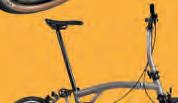



















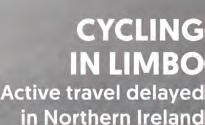























MOUNTAIN BIKING MADEIRA SITTING COMFORTABLY? SADDLE TIPS LEICESTERSHIRE & RUTLAND RIDE GUIDE AND MUCH MORE




































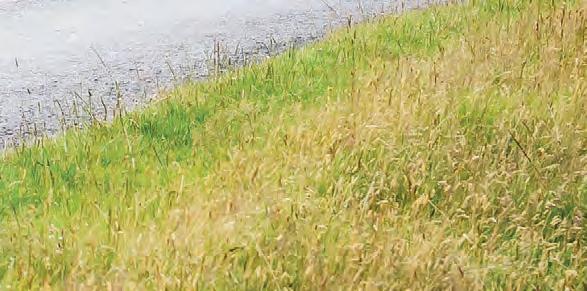
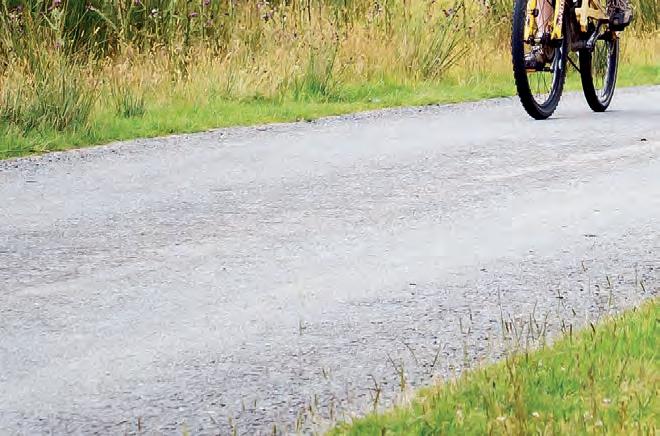
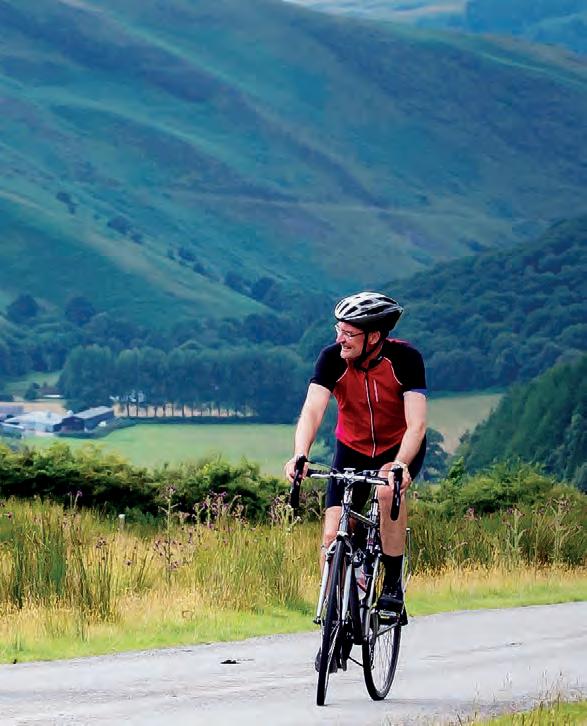
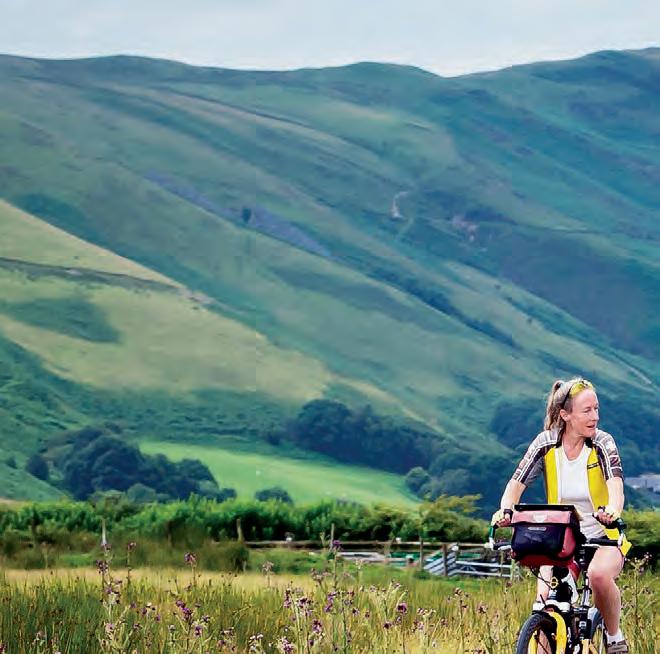

88 A MONTH!*

When it comes to using bikes instead of cars for short trips, experienced cyclists like us are outliers. It’s easy for us. Heading into town? Put shoes on. Get on bike. Go. No thought required.
We can even use bikes for utility trips that others wouldn’t register as rideable. Last summer I was going to York Rally – about 40 miles away as the crow flies and close to 50 by any route you’d want to ride. I’d normally take the train but it wasn’t running. (Thanks, TransPennine!)
“No problem,” I thought, “I’ll take the bus.” The timetable said two hours for the journey. Factoring in walking and waiting at each end, it’d be around three. I figured I could ride there in that. So I did (2:52 there, 3:05 back). It was a nice day out.
Most trips made in the UK aren’t this kind of length: 71% of them are under five miles. You don’t need to be capital-C cyclist to ride that. Most people could do it, if they chose to. We know there are lots of reasons why they don’t. Two of the biggest are the perception that cycling is dangerous (“roads too busy”), and the idea that cycling is hard.
Better infrastructure is a long-term project that won’t be fixed overnight. Making cycling easier? That’s instantly achievable with an e-bike. If we (as a country, not as cyclists) are serious about getting people out of cars, e-bikes are surely part of the solution. They make everyday cycling more accessible for people who aren’t lifelong cyclists like us.
DAN JOYCE Cycle Editor

32 Coasting through Sweden
On the 390km Kattegattleden bike path
38 Power to the people
How electric bikes can give people the boost to cycle instead of driving
47 Cycling in limbo
Northern Ireland’s failure to invest in active travel

50 Sun, sea & singletrack
Mountain biking on the island of Madeira

18 Shop Window
New products previewed
20 Gear up
Components, accessories, and books
60 Comfort, not speed
Endurance road bikes from Cannondale and Spa Cycles

66 Brompton T-Line One
A 7.5kg titanium Brompton
69 GPS devices
GPS devices with satnav-style navigation
04 Freewheeling
Bits and pieces from the bike world
07 This is Cycling UK
Drivers switching to cycling thanks to BBR; raising awareness of the revised Highway Code; win an e-bike in our raffle; and more
16 You are Cycling UK
The founder of Bikes for Refugees
Scotland
29 Letters
Your feedback on Cycle and cycling
44 Weekender
An early-season 100k ride with Leicestershire & Rutland CTC
54 Cyclopedia
Questions answered, topics explained
73 Travellers’ Tales
Cycling UK members’ ride reports

9JX E: cycling@cyclinguk.org W: cyclinguk.org T: 01483 238300. Cycle promotes the work of Cycling UK. Cycle’s circulation is approx. 51,000. Cycling UK is one of the UK’s largest cycling membership organisations, with approx. 70,500 members and affiliates.
President: Jon Snow Chief Executive: Sarah Mitchell. Cyclists’ Touring Club, a Company Limited by Guarantee, registered in England No 25185, registered as a charity in England and Wales Charity No 1147607 and in Scotland No SC042541. Registered office: Parklands, Railton Road, Guildford, GU2 9JX.
CYCLE MAGAZINE: Editor: Dan Joyce E: editor@cyclinguk.org Designer: Christina Richmond Advertising: Bevan Fawcett T: 0203 198 3092
E: bevan.fawcett@jamespembrokemedia.co.uk Publisher: James Houston. Cycle is published six times per year on behalf of Cycling UK by James Pembroke Media, 90 Walcot Street, Bath, BA1 5BG. T: 01225 337777. Cycle is copyright Cycling UK, James Pembroke Media, and individual contributors. Reproduction in whole or in part without permission from Cycling UK and James Pembroke Media is forbidden. Views expressed in the magazine are those of the individual contributors and do not necessarily reflect those of the editor or the policies of Cycling UK. Advertising bookings are subject to availability, the terms and conditions of James Pembroke Media, and final approval by Cycling UK. Printed by: Acorn Web Offset Ltd, Loscoe Close, Normanton Industrial Estate, Normanton, WF6 1TW T: 01924 220633

UK: Parklands, Railton Road, Guildford, GU2
Where: Southern Sweden
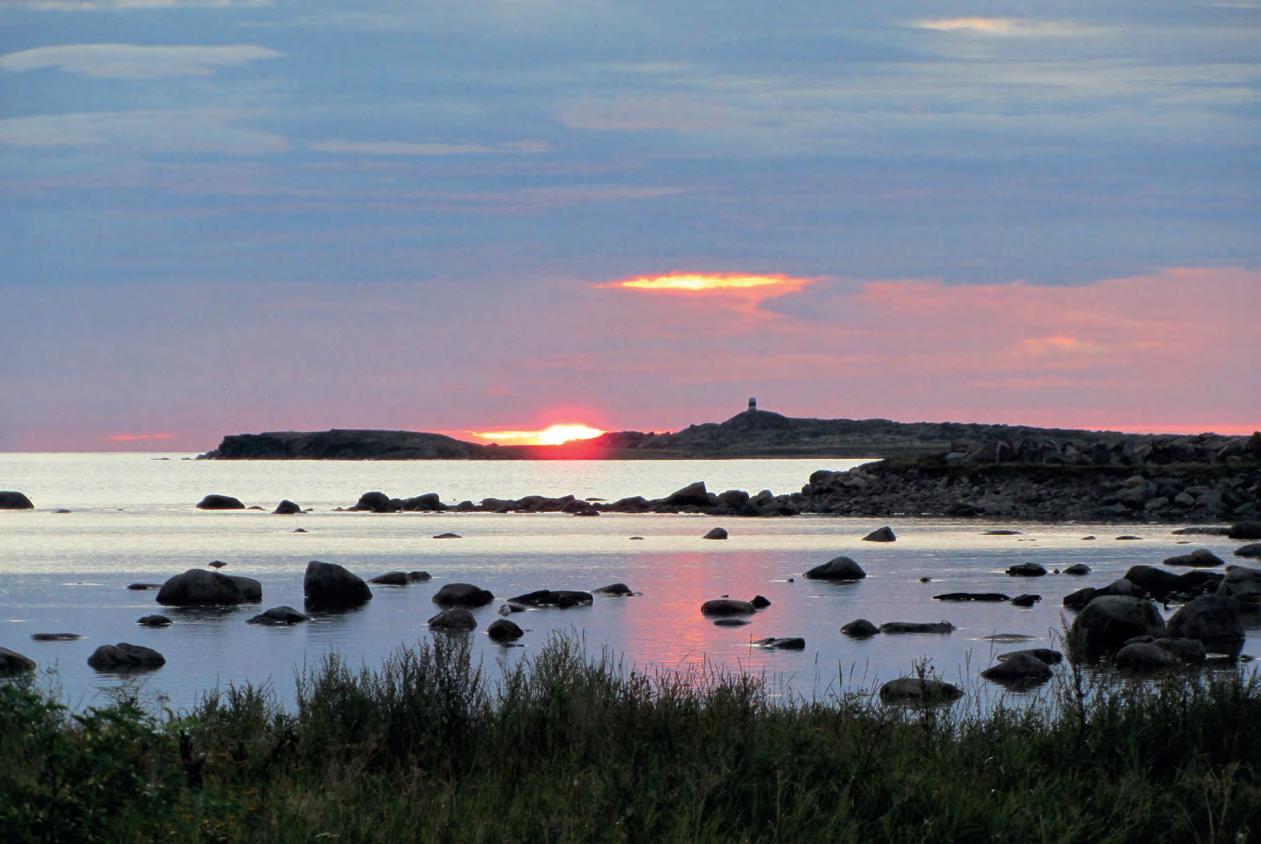
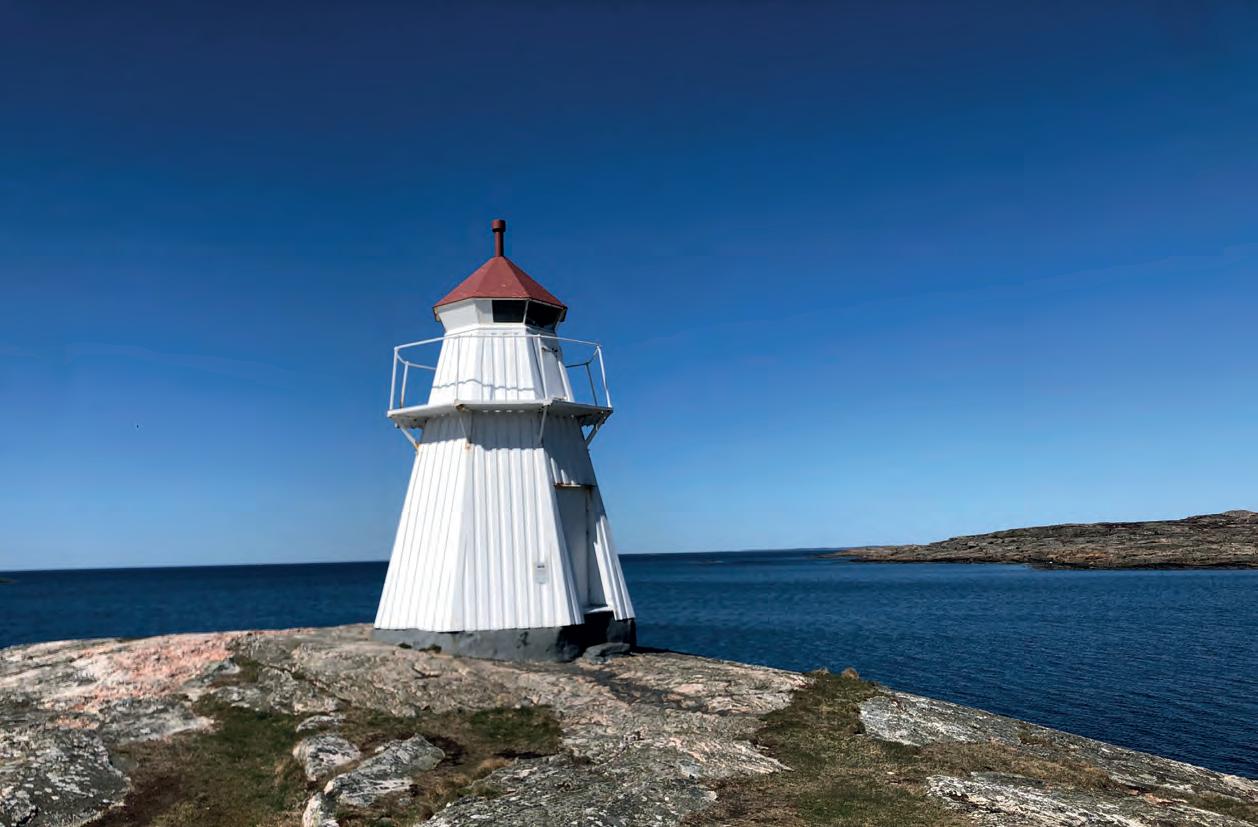
Start/finish: Helsingborg to Gothenburg
Distance: 390km in total
Below:
 Top: Bay near Träslövsläge harbour
Headland, Bua
Photos: Paul Lloyd
PAUL LLOYD Cycling UK member
Top: Bay near Träslövsläge harbour
Headland, Bua
Photos: Paul Lloyd
PAUL LLOYD Cycling UK member
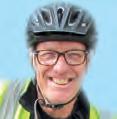
Kattegattleden is a 390km cycle path along the country’s western coastline. Part-time resident Paul Lloyd sings its praises
Sweden’s premier long-distance cycling route, Kattegattleden, runs right past the bottom of the garden of our house in Sweden. So in spring and summer, when we are there each day, we look out of our dining room window at a steady flow of cycle tourers and other cyclists going north or south.
Kattegattleden takes its name from the sea between Sweden and Denmark: Kattegatt. The route follows the coast from Helsingborg in the province of Skåne in the very south of Sweden, through the next province going north (Halland), and finishes in Gothenburg in the province of Bohuslän, closer to the border with Norway.
Cycle tracks comprise much of the route, with occasional sections on small lanes or dirt roads away from the regular flows of motor traffic. It was created on 6 June 2015 as the first national long-distance cycle route in the country. Before that it existed as just an assembly of regional and local routes – Ginstleden in the south and Sverigeleden in the north. One of main benefits of the transition to Kattegattleden has been a major improvement in signposting. This makes navigating the route very easy.
Back in 2011, when it was classed as Ginstleden, I cycled the southern section from the fishing village of Träslövsläge (where our home is) to Helsingborg. It was about 220km over three days. Ginstleden means ‘the pathway through gorse bushes’. For me it was a lovely introduction to long-distance cycling in Sweden, having just brought over one of my touring bikes from England to begin a more
serious spell of riding and exploring the Swedish countryside.
On a recent visit to Sweden I decided I would complete the remaining section of the full Kattegattleden route by riding the final two days of the northerly section from our base in the Träslövsläge. It seemed like good way to loosen up for a longer journey down the west coast of France that I was due to take on before the end of the month.
But the experience also served to remind me of the pleasures of cycle touring in Sweden, a country of just 10 million people and twice the land mass of the UK. Much of it is forested, especially in the north, and there are thousands of lakes and rivers. It must have the freshest and cleanest air in Europe.
On the southerly sections of Kattegattleden the coastal landscape is different from what you encounter further north. The south is generally flatter and offers a less rocky and forested terrain, which is more characteristic of the landscape of Bohuslän. There are more long sandy beaches along this southern stretch of coast.
Until the 17th century the provinces of Skåne, Halland and Bohuslän were all part of Denmark. They were ceded to Sweden after a number of wars between these Scandinavian neighbours.
The buildings and especially the churches in southern Halland and Skåne have the appearance of those in Denmark, with

Much of Sweden is forested, especially in the north, and there are thousands of lakes and riversLifelong cycle touring enthusiast dreaming of the next trip
ELECTRIC BIKES CAN PROVIDE THE BOOST PEOPLE NEED TO START CYCLING THE SHORT TRIPS THEY’D OTHERWISE MAKE BY CAR.
JOANNE CLARK SPOKE TO THREE SWITCHERS

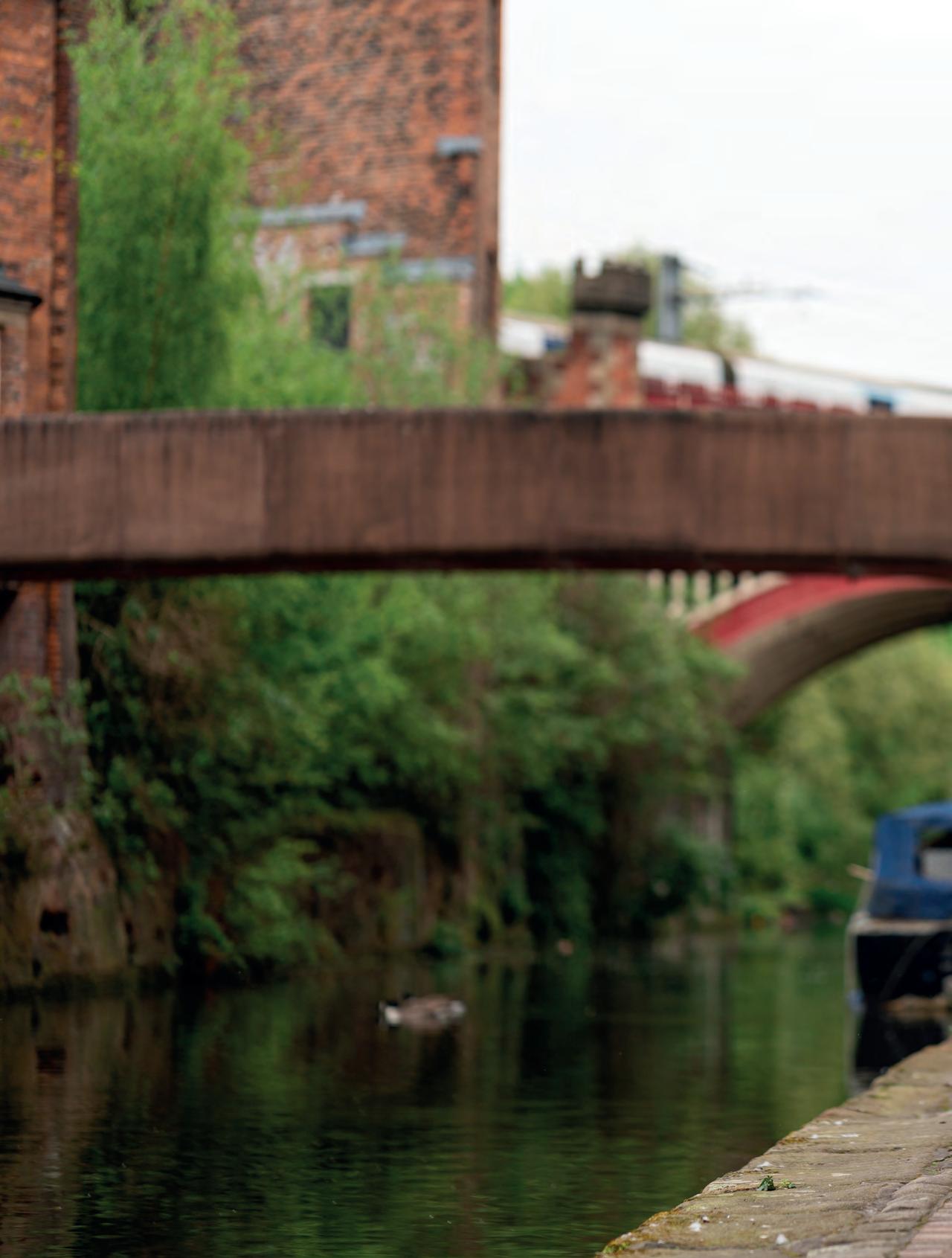
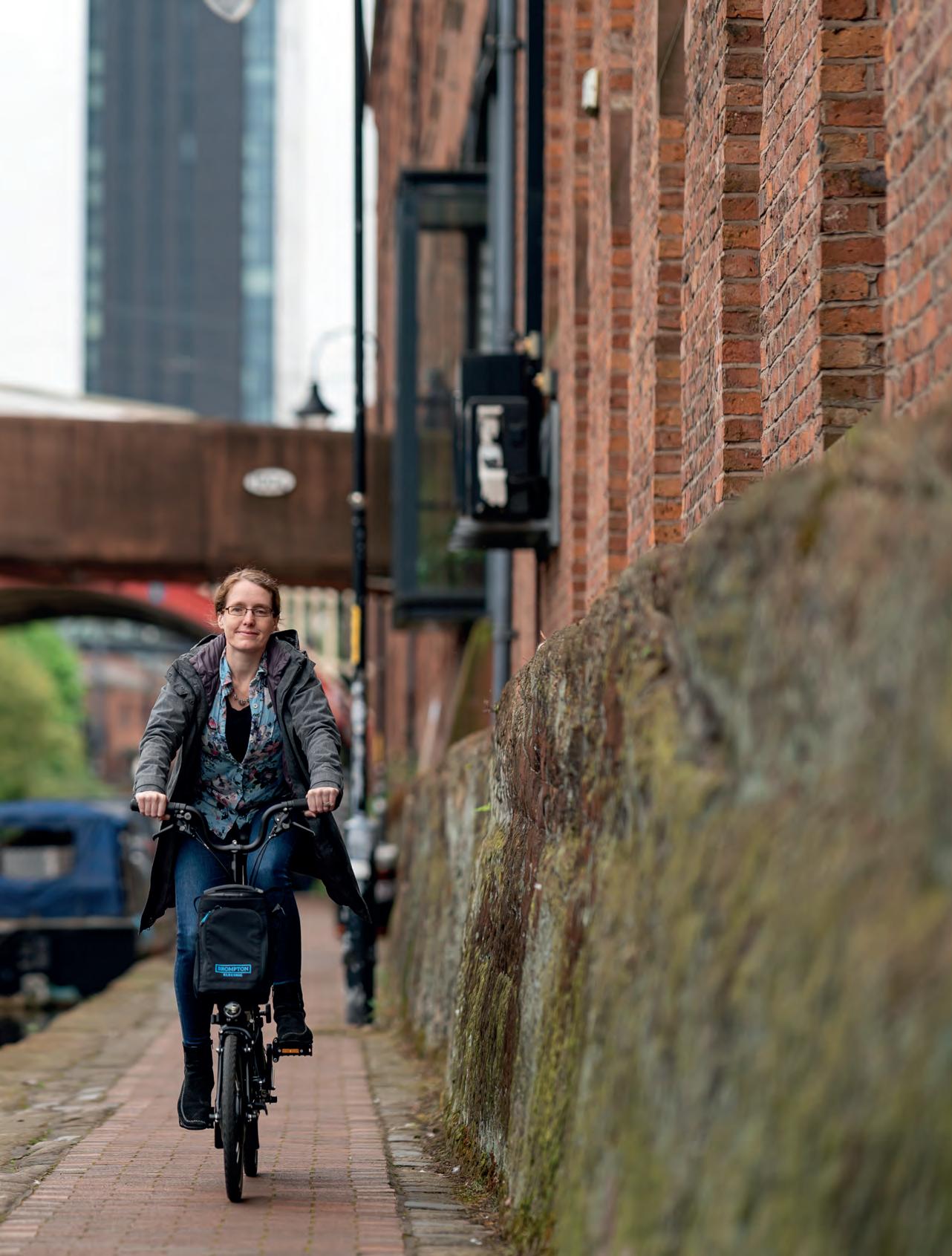
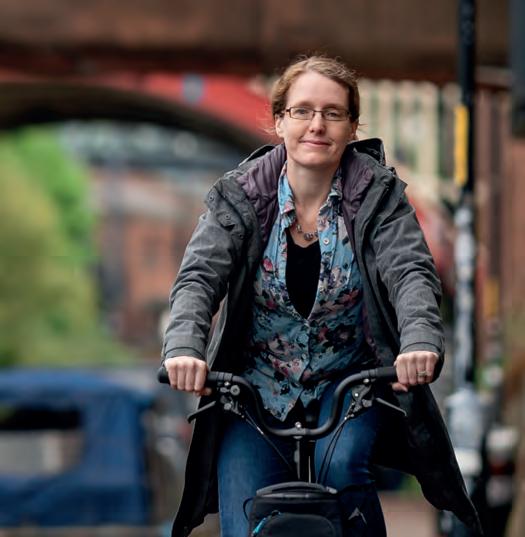
The Portuguese island of Madeira makes a great destination for enduro-style mountain biking. Ralph Jessop returned for his third visit
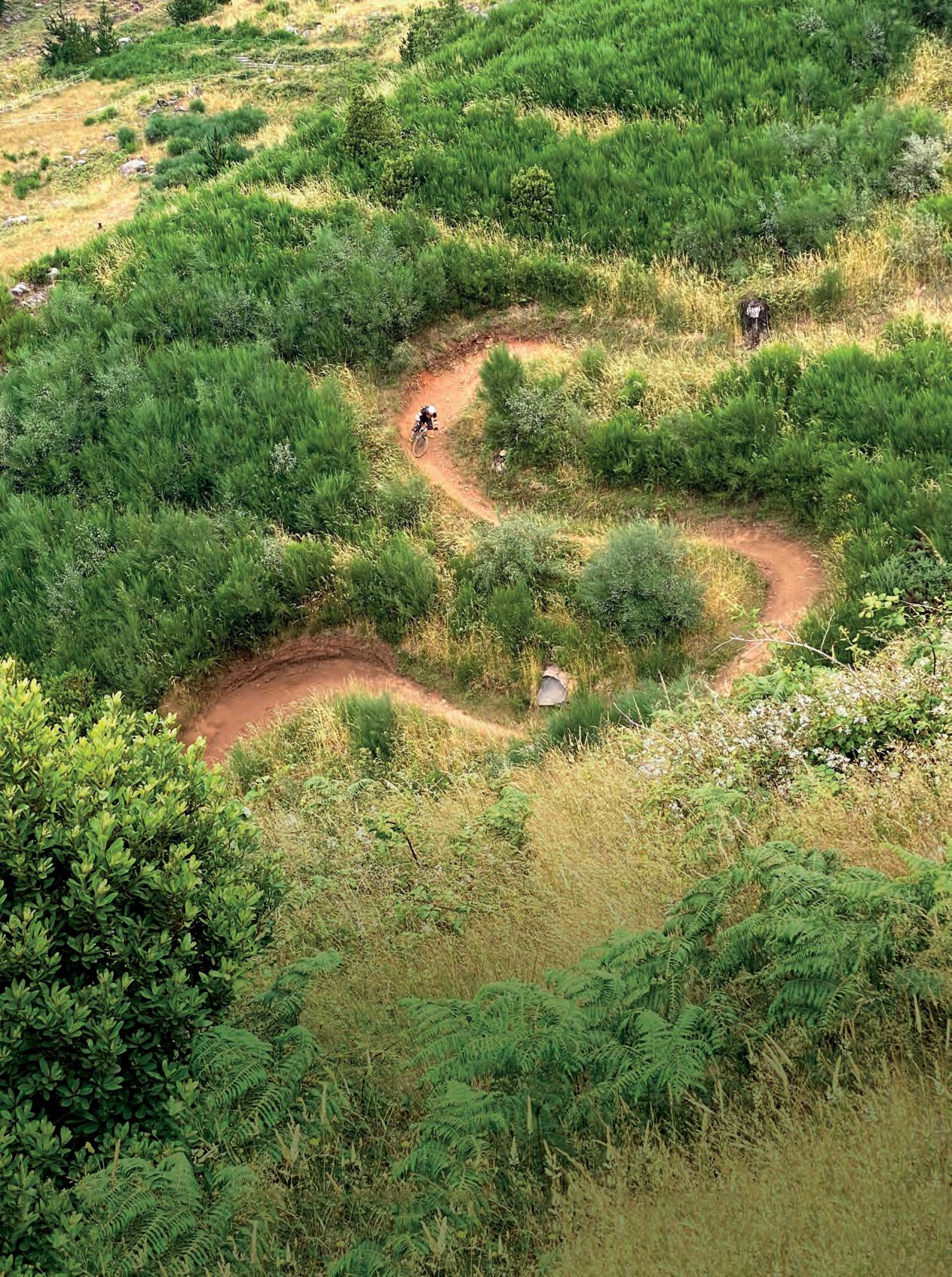
Madeira rises like a mountain range from the Atlantic. As your plane swoops around the island, you get a good view of its peaks and gradients. There’s so little flat land that the airport runway stretches out into the sea on concrete pillars, and the hotel transfer involves one of the twistiest, most elevated journeys you’ll ever make by coach. So you can image what the biking trails are like.
Next day I was ready to reacquaint myself with them. I was sitting on a cling-film-covered seat in VW minibus owned by Freeride Madeira, with whom I’d booked a couple of days' riding. Having been here before, I was enjoying the expressions of companions who hadn’t as they began to realise that the previous day’s coach trip was nothing compared to the bike shuttle that was taking us to the top of the island. The roads are so narrow, so steep, and so twisty. Our driver, Andre, revved the van into first gear as he took a hard right up a road like a ramp. Imagine Hardknott Pass, double everything about it, then add some exposure…


We bundled out of the van and took in the view. It was like being on top of the world. Mountain scenery lay below us, surrounded by sea. I could tell what the other riders were thinking: if that was the drive up, what about the trails down?
The top section was a dusty flow-trail through scrub. After rain the surface is affectionately named ‘Madeiran ice’ but even dry it was challenging. A few corners in, after some berms and small drops, I realised that this much dust demanded new techniques. It needed to be treated more like a wet trail in the Highlands. And it was best to keep some distance from rider in front. Too close and it was like being on a plane descending into cloud: you couldn’t see a thing.
Some lovely, technical boulder sections, rollable step-downs, and more steep berms delivered us onto a mountain road. Andre was waiting with the van and showed us how to load the bikes onto the trailer. Six dust-covered riders climbed into the van for a short shuttle back up, laughing and talking up the descent.
Disembarking, we tweaked the setup of our hire bikes and dropped into a forest. It was like being back in the UK on a perfect summer’s day: Dunkeld but with 27-degree heat. On this more familiar terrain of rooty singletrack, everything started to come together and I felt like I could ride full tilt.
The first time I rode in Madeira was on the trails used for the Enduro World Series. I’d never ridden anything so steep. Trail development in the UK has caught up in recent years, and this time I felt more at home. I tried to lay off the brakes, stay smooth, and keep up with the younger riders in front. Technical singletrack led us through different habitats


– pine woods, breezy meadows, Australian-style gum tree forests – beneath crystal blue skies. I was already plotting how I could return next year.


The Madeira archipelago sits a long way off the coast of Portugal – it’s nearer Africa. I flew direct from Edinburgh with Jet2, which took about four hours. There are flights from most major airports in the UK. The ferry service between Portimão (mainland Portugal) and Funchal (Madeira) stopped running a while ago. If you want an off-season mountain biking getaway without flying, southern Spain, the Balearic Islands, and (for the really dedicated, well-heeled traveller) the Canaries are accessible by train and ferry. Details on how to get there are on seat61.com


Dan happily rides century rides in unpadded shorts
Saddle discomfort is a common problem. To avoid it, you need a saddle that’s the right shape and width for your bum and your preferred riding position. And that saddle needs to be set in a position that suits you and the way that you ride. Padded shorts can help but are unlikely to solve underlying issues by themselves.
The only infallible way to choose the right saddle is to try different ones on your bike. Some shops have saddle libraries – see cyclinguk.org/article/ how-choose-right-saddle for a link – enabling you to try different ones to see what works best.
The right saddle will support your weight on the bony parts of your pelvis rather than the soft tissue in between, avoiding pain and/or numbness. Your pelvic bones are narrower at the front than at the back, where your sit bones are. So the saddle width required also depends on your riding position. Leaning forward on a road bike calls for a narrower saddle than sitting upright on a commuter.
The need for padding differs by usage, too. On a Dutch roadster, with almost all of your weight on your bum, padding and/or springs are helpful. On a road bike, with more of your weight borne by hands and feet, a harder saddle may suit.
The more you lean forward – especially women
One of these might (and only might) work for you.
Charge Spoon shape suits lots of bottoms. freewheel.co.uk
– the more perineal or (ouch!) genital pressure you can expect. That’s why sportier saddles in particular have cut-outs and channels: to relieve pressure. For a given riding position, they may be the difference between comfort and pain.

Your riding position isn’t set in stone, however. If you move the handlebar closer and higher, using a shorter and/or taller stem (or a different frame), you’ll sit up more: the wider part of your pelvis will then bear your weight. Part of saddle comfort is handlebar position.
Saddle height matters as well. Too high and you’ll rock your pelvis, causing chafing or other undercarriage discomfort. If that sounds like you, try lowering your saddle in 5mm increments. (To ensure your saddle is high enough, the heel-onpedal-method works fine. See cyclinguk.org/ guide/make-bike-fit.)
For saddle angle, start with it horizontal. Tilting the saddle nose down a few degrees (or maybe more) can help if the handlebar is notably lower than the handlebar. Tilting up is less common but might work for a more upright riding position. Whatever you do, never persevere through pain.
Bike fitters may steer you to a certain saddle width after measuring your sit bones with pressure pads. You can check this yourself with corrugated cardboard, a felt-tip pen, and a ruler. Put a laptop-sized piece of cardboard on a low, flat stool. Sit on it, wearing bike shorts or not-too-thick trousers. Hold the sides of the stool and pull yourself down onto it. Stand up. There will be two indentations in the cardboard. Draw a cross in the centre of each. Measure between the crosses. That’s your sit bone width. If it’s less than about 100mm, you should fit narrower saddles. If it’s 100120mm, you should fit average-width saddles. If it’s over 120mm, look at wider saddles. As a rule of thumb, buy a saddle that’s at least 20mm wider than your sit bones. But if wider is more comfortable, get that instead.
Plush perch for upright commuters. specialized.com
Unpadded but shape suits some. rido-cycling.com

Like other ISM seats, the split nose relieves pressure. ismseat.com

Brooks’ best-selling leather saddle. brooksengland.com


MEMBERSHIP FROM JUST £3. 88 A MONTH!*
MEMBERSHIP FROM JUST £3. 88 A MONTH!*







First look Versatile aluminium all-rounder with disc brakes, decent clearances, and practical touches
Road bikes don’t have to be designed for racing. Simon Withers tests long-distance all-rounders from Spa Cycles and Cannondale

There’s more than one way to design a comfortable road bike for year-round riding, club runs, sportive or audax events, and commuting. The two test bikes both have 28mm tyres, a carbon fork, rack and mudguard mounts, and geometry that’s designed for long days out rather than racing. But the similarities pretty much end there.
Spa Cycles’ Steel Audax 105 is a traditional take on the endurance road bike, with skinny steel tubes, rim brakes, and a name that underscores what it’s for. Cannondale’s Synapse Sora typifies modern trends, featuring much larger diameter aluminium tubes and disc brakes. While there is a difference in price, both bikes look to be good value. Spa’s bikes always are, and Cannondale’s Synapse is only £150 more than in 2018 – a nice surprise in these inflation-ravaged days.
Spa’s Steel Audax has a TIG-welded Reynolds 725 chromoly frame, though all sizes except the 50cm model have a carbon-bladed fork with a straight
1 1/8in aluminium steerer. The test bike’s fork steerer had been left long, which results in a lower-back-friendly ride that’s good for urban riding and touring. It’s excellent for seeing and being seen but you could cut down the steerer – or run more of the spacers above the stem – for a lower and more athletic riding position. The frame’s rear triangle has separate mounts for the rack and mudguards, and the chainstay bridge is mudguard ready.
While the TIG-welding isn’t quite the neatest I’ve seen, I don’t doubt its functionality. The frame should last a lifetime as the steel is ‘ED coated’; this ‘electrophoretic deposition’ ensures a uniform thickness of paint. The finish is excellent: beautifully deep and lustrous.
There’s clearance for 28mm tyres with mudguards. Even without ’guards you’d struggle to fit tyres wider than 32mm, so it’s best suited to tarmac, smooth tracks,






and lighter loads. In many ways, including the colour, it reminds me of my first ‘serious’ road bike: a 1984 Raleigh Clubman. The Spa’s components and ride are superior, however. Not everything was better back in the day!
Cannondale was a pioneer in aluminium frame building so it’s no surprise to see a neatly welded, oversize aluminium frame at the heart of the Synapse. It features a chainstay bridge drilled for a mudguard and single eyelets at the rear dropouts for a mudguard and rack to share. The rear dropouts are quick release rather than a thru-axle, presumably as a cost saving. There’s clearance front and rear for 35mm rubber.
The frame is accompanied by a fullcarbon fork that uses Cannondale’s ‘SAVE technology' – which is to say, the design and carbon layup are intended to improve comfort. The fork has a 12mm thru-axle, to make the most of the disc brake, and mudguard mounts on the inner faces of the fork blades. The steerer is tapered to maximise front-end stiffness.
The price difference between the two bikes is evident to some degree in the components, though if I’d tested the next model up in the Synapse range – the £1,200 Tiagra – the disparity wouldn’t have been as striking.

Spa’s Steel Audax 105 is equipped, as you’d expect, with Shimano’s 11-speed 105 groupset. A 50-34 double chainset is paired with an 11-32 cassette, though Spa can fit a bigger cassette to give a lower bottom gear if you prefer. (It’s also available with a triple chainset.)
Shifting is light, smooth and accurate, and the brakes are easy to set up and easily good enough for the steep descents around Bath, where I live. With 11 sprockets, the gaps between gears are less obvious than on the nine-speed Cannondale.
Spa doesn’t use Shimano 105 for the brake callipers. Instead they’re Tektro R737; the deeper-drop design allows the use of 28mm tyres and mudguards. Those full-length SKS mudguards are very effective at reducing the spread of
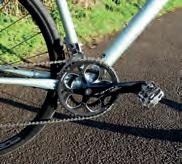
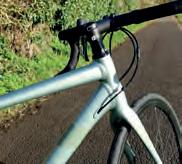

Price: £1,000.
Sizes: 48, 51, 54, 56, 58, 61cm.
Weight: 10.36kg (54cm, no pedals).
Frame & fork:
SmartForm C2 alloy frame with fittings for flat-mount disc brake, rack and mudguard, and two bottle cages.
Full-carbon SAVE fork with tapered steerer, 12×100mm thru-axle, and fittings for flatmount disc brake and mudguard.
Wheels: 28-622

Vittoria Zaffiro tyres, RD 28h rims, stainless steel 14g spokes, Formula CRX-512 12×100 thru-axle front, alloy quickrelease rear.
Transmission: no pedals, FSA Vero
alloy 50-34 chainset, FSA cartridge BB30 bottom bracket, KMC Z9 9-speed chain, Shimano HG400 11-34 cassette. Shimano Sora shifters, Shimano Sora front and rear mech. 18 ratios, 27-121in.
Brakes: Promax Decoder R cable disc, 160mm rotors. Steering & seating: Cannondale Grip bar tape w/gel 3.5mm, Cannondale 6061 compact alloy bar, Cannondale 4 6061 alloy stem (31.8mm, 7°), threadless headset. Cannondale Stage Ergo saddle, 25.4×350mm Cannondale seatpost. cannondale.com
The Synapse handles confidently even on unsurfaced tracks like towpathsTop: Internal cabling keeps things tidy. Replacement is more fiddly, of course
MEMBERSHIP FROM JUST £3. 88 A MONTH!*
MEMBERSHIP FROM JUST £3. 88 A MONTH!*














Better-quality GPS devices offer satnav-style mapping and navigation as well as typical bike computer functions.


 Katherine
Katherine
Moore tests four units
KATHERINE MOORE
Katherine is a keen bikepacker and off-road rider who created the East Devon Trail (eastdevontrail. com) during lockdown

GPS bike computers have revolutionised how we ride, with many models offering satnav-type mapping and turn-by-turn route navigation. Forget having to stop at each junction to check the paper map: these handy electronic devices can help keep you on your pre-planned route as you pedal, or display mapping so you can explore as you please.
While all GPS cycle computers will be able to record your ride and give you metrics such as speed and distance, modern units also boast comprehensive mapping functionality. These can load cycle routes in the form of GPX files and can often be linked to a companion app on your mobile so you can adjust your route on the fly.
You can scroll through a series of screens on your unit to see ride data and maps, which you can zoom in and out of to see more detail or move around, just as you might with digital maps on your phone or PC. Most GPS units can also display an elevation chart of your route, with more advanced models also boasting clever climbing features to help keep you informed about the challenges ahead.
While modern phones can also offer satnav-style navigation, given the right app, GPS units tend to last a lot longer before needing to be recharged.











At Cycle, we are proudly independent. There’s no pressure to please advertisers as we’re funded by your membership. Our product reviews aren’t press releases; they’re written by experienced cyclists after thorough testing.


If you enjoy long rides or cycling on consecutive days, opting for a cycling GPS unit with a good battery life will be a wise move. Screen brightness and the energy demand of routing will both drain the battery, so check the capacity carefully before making your choice.


Pricier GPS units will offer colour displays, which can be really useful for distinguishing between rivers, roads and different trail types on mapping modes. Besides the screen, some units also use LED lights that can be programmed to
alert you to upcoming navigational cues.

Operation Cycle computers either use buttons or a touchscreen – or a combination of the two – to enable you to move between screens. Mounts are supplied, positioning the computer on handlebar or stem for easy viewing as you ride.
More advanced cycle computers allow you to choose what ride data you prioritise, whether that’s simple measures like speed and distance or more complex information such as power output, heart rate zones or ambient temperature.

Northumberland

You need plenty of energy for this 120-mile trek across Northumberland. John Whittle and friend Rob took some extra: 625Wh batteries
The Sandstone Way is designed as a north-south route, starting in Berwick-upon-Tweed and ending in Hexham. There are various ‘official’ permutations; the route Rob and I tackled was 198km with 3,408m of ascent. We did it over four days in the heatwave of July 2022, not long after Storm Arwen, using 625Wh Bosch-powered e-bikes.

A-to-B journeys require serious logistics: getting to the far end, recharging riders (and bikes), leaving transport at A or B, and getting back to collect it. We booked our accommodation in advance and travelled light.
The start was hot and windless. After a glorious ride down the coast to Holy Island, we pedalled into the Kyloe Hills and the beautiful, simmering interior of a silent, baking world. Rob, a retired GP, watched over our health, insisting we drank enough. We crawled into our first night’s stop bloodied and beaten.
Local refreshments and large helpings of pie and chips saw morale climb, however. In the purple, misty dawn of day two we undulated through stunning landscapes, waiting in the shaded hills above molten Rothbury as the temperature topped 40°. We glugged down another seven litres that day.
The riding varied from very technical to quiet country lanes, using a long ingenious chain of tracks and paths.
There was no ‘hike a bike’ and, after day one, we saw no sign of anyone else. The preloaded GPS kept us nearly on track throughout. What the maps do not reveal is the 170-plus gates…
Disaster struck when we discovered that Storm Arwen had blasted the forests of day three into an impassable tangle. Two elderly, sunburned riders on electric bikes attracted generous local advice. Thanks to that we cruised into Bellingham, avoiding the worst of Simonside Forest and enjoying the best mountain biking of the route.
Our last day was shorter but hilly, with fierce climbs and more gates. As the temperature eased, we sped through wild Hadrian’s Wall country to Hexham.
It’s not a route for the timid, needing good navigational skills, the tenacity to find one-night-only accommodation, and help dodging blasted forests. If 2023 is as hot as 2022, make sure to drink lots of water if you ride it.
HAVING ENJOYED
MANY holidays in the Ardèche in the south of France, I had long wanted to ride in the Ardèchoise sportive: a four-day festival of cycling in which 10,000 enthusiasts take on one of numerous routes around this scenic département.
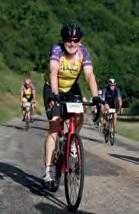

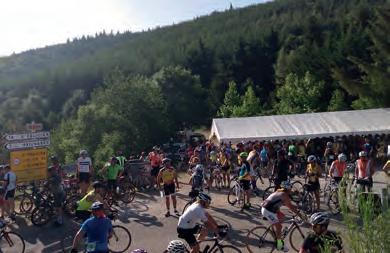
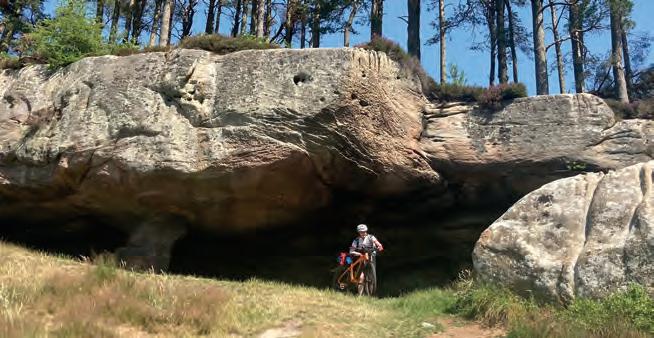
At the age of 66 and used to cycling in the relative flatlands of Suffolk, I chose one of the easier routes: a day ride of 125km with 2,500m of climbing. So it was that I arrived at the start town of St Félicien in the middle of June 2022, with temperatures already approaching 30°.
After 14km and the first of five challenging climbs, the pattern for the day was established: eat, drink, recover, and cool off with plenty of cold water on the head and feet. From the first summit came the relief of the descent, with sweeping curves and welcome breezes.
As the day wore on and the heat increased, the climbs became ever more challenging. Yet although there was the occasional ‘Garmin auto-pause of shame’, I never had to resort to getting off and walking. Reward for the climbs came not only from the fantastic descents but also the stunning Ardèchoise scenery.
I finally rolled into St Félicien after 11 hours –seven cycling, four stopped to cope with the heat. It was a really satisfying achievement, helped by fantastic organisation.
www.ardechoise.com
More online
Fancy contributing to Cycle?
Read the guidelines here: cyclinguk.org/be-part-cyclemagazine
When Nick Murphy finally rode the Ardèchoise sportive, it was in 35°C heat